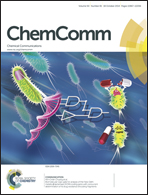Copper-catalyzed cyanation of disulfides by azobisisobutyronitrile leading to thiocyanates†
Abstract
The copper-catalyzed cyanation of disulfides by azobisisobutyronitrile (AIBN) was developed, leading to thiocyanates in moderate to good yields. This procedure tolerates a series of functional groups, such as chloro, nitro, methyl and methoxycarbonyl in the phenyl ring of disulfides. Notably, it enables the use of two ArS units in (ArS)2. CuI was found to be essential for the in situ formation of cyanide anions.


 Please wait while we load your content...
Please wait while we load your content...